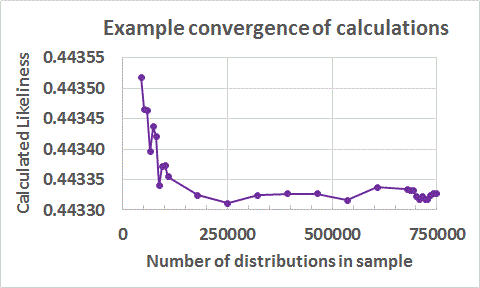Lovegrove Mathematicals
"The home of great likelinesses"
There are some Theorems which can be of help but which apply only to simple circumstances. In practice, reliance has to be placed on a computer program to carry out the calculations.
Great Likelinesses is my own command-line program for doing the routine things one needs to do when dealing with likelinesses. It works by taking a random sample of distributions from the underlying set and substituting them into the definition of likeliness: this needs specially-developed algorithms. The number of distributions needed in the sample varies depending on what is being done.
Great Likelinesses has been designed to cater for a sample of up to 1 billion distributions from the underlying set, but defaults to using a sample of 750,000. For simple analyses, 25,000 might be more than enough. For really complicated work, 25,000,000 might not be sufficient.

For routine problems using the defaulted 750,000 distributions, typical run-times (once the data have been input) are as in the table.
| Underlying Set | Degree, N | ||||||
| 2 | 5 | 10 | 25 | 50 | 75 | 100 | |
| B(N)The set of Bell-shaped distributions | 1 | 2 | 3 | 9 | 23 | 42 | 68 |
| S(N)The set of all distributions | 2 | 3 | 5 | 13 | 32 | 60 | 115 |
| R(N)The set of Ranked distributions | 2 | 3 | 5 | 13 | 33 | 61 | 117 |
| M(N)The set of Unimodal distributions | 2 | 3 | 7 | 18 | 47 | 89 | 172 |
| U(N)The set of U-shaped distributions | 2 | 3 | 7 | 18 | 49 | 90 | 174 |
| Typical run-times (seconds) | |||||||
Great Likelinesses caters for the following:-
Great Likelinesses is suitable for running only on 64-bit PCs. I'm sorry, but I don't have the time, patience, knowledge or interest to produce it in any other format. If you find that it does run in some other environment then consider yourself fortunate, but please let me know so that I can tell others.
A new Release is made available once significant changes have been made to the current one. Each Release is made available in two versions: the Full Version and the Classic Version.
The Classic Version is restricted to degrees which have some significance in the classic problems to do with coins, dice and cards: there are quite a few of these, so the Classic Version might be all that you currently need. The Classice Version is always published first.
It has been written in FORTRAN, and therefore has been compiled as a .exe runfile. If you would like a copy (no charge) then please contact me using the email address on the home page, and we'll see if we can work out a mutually-acceptable way for me to get it to you: it is not possible to email a .exe file since these are routinely blocked by most email clients because of security concerns, even if wrapped in a ZIP archive.